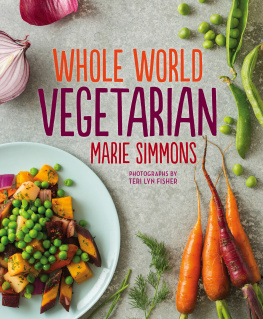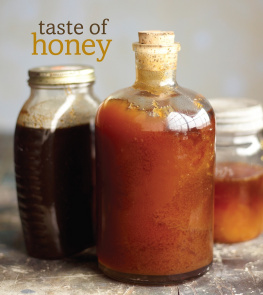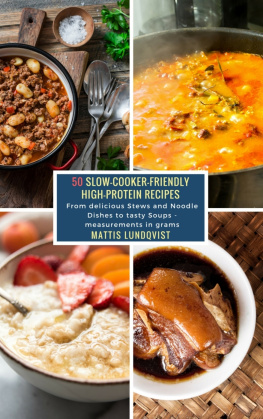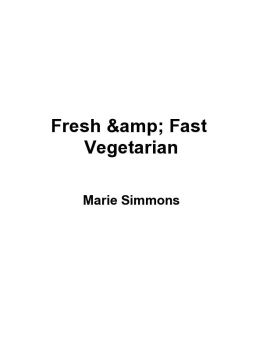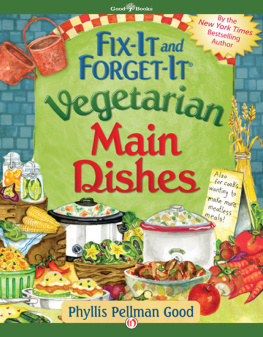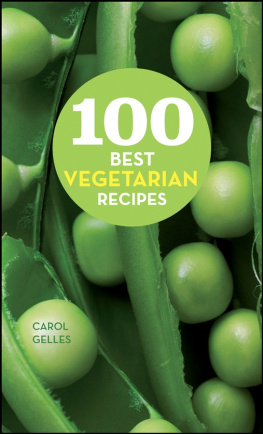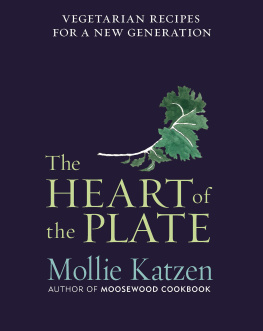CONTENTS

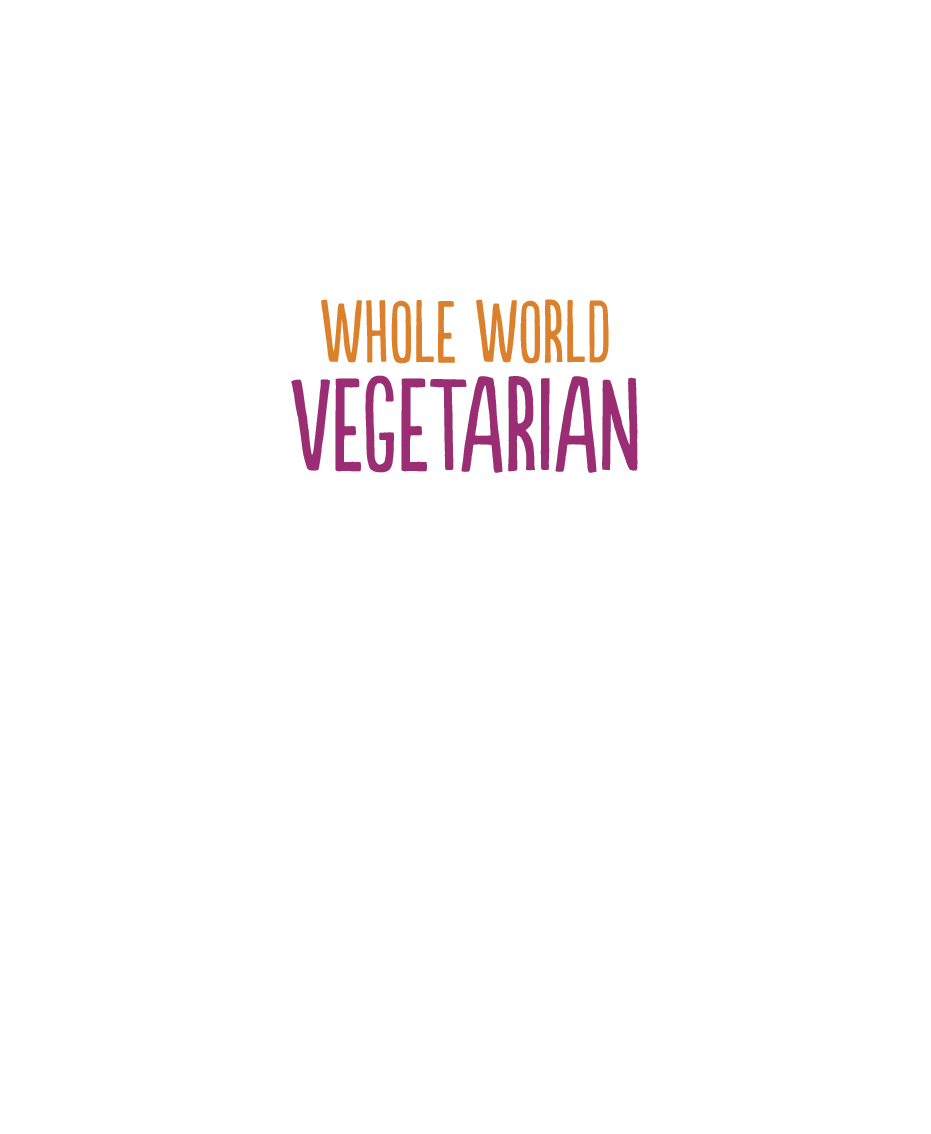


Copyright 2016 by Marie Simmons
Photographs copyright 2016 by Teri Lynn Fisher
All rights reserved
For information about permission to reproduce selections from this book, write to or to Permissions, Houghton Mifflin Harcourt Publishing Company, 3 Park Avenue, 19th Floor, New York, New York 10016.
www.hmhco.com
Book design by Toni Tajima
Food styling by Jenny Park
Prop styling by Teri Lynn Fisher
Library of Congress Cataloging-in-Publication Data
Names: Simmons, Marie, author.
Title: Whole world vegetarian / Marie Simmons ; photography by Teri Lynn Fisher and Jenny Park.
Description: Boston : Houghton Mifflin Harcourt, 2016. | A Rux Martin book.
Identifiers: LCCN 2015044198 | ISBN 9780544018457 (paperback)
Subjects: LCSH: Vegetarian cooking. | BISAC: COOKING / Vegetarian & Vegan. | COOKING / Regional & Ethnic / General. | COOKING / General. | LCGFT: Cookbooks.
Classification: LCC TX837 .S48683 2016 | DDC 641.5/636dc23
LC record available at http://lccn.loc.gov/2015044198
eISBN: 978-0-544-01845-7
v1.0516

ACKNOWLEDGMENTS
Once again the maxim it takes a village proves its point. Except in this case, it has taken much more than that. It has taken family, friends, neighbors, colleagues, and most of all, cooks from around the world. I thank all of you for your generosity of ideas and for your passion for cooking.
Before I get down to the nitty-gritty, I must thank my brilliant agent, Carole Bidnick, and her equal, my longtime and much-loved editor, Rux Martin.
A heartfelt thank-you to our talented photographers, artists, and stylists Teri Lynn Fisher and Jenny Park, and to the gifted designer Toni Tajima for creating such a beautiful cookbook. I love what youve done. On the same note, I am blown away by the clean, clear, sensible editing by Stephanie Fletcher. Somehow Stephanie managed to get into my head and give the recipes that Im your friend in the kitchen voice that is so important in recipe writing. Thank you, Stephanie.
Getting down to the wire and fearing there was more to do than any mere mortal should have on her plateplus the fact that my eyes were blurringI owe a huge debt of gratitude to my good friends Brooke Jackson, Marcia Maffei, and Michele Postal for pitching in with recipe retesting and checking, and meticulous proofreading. Also, thank you to my granddaughter, Seraphina; my daughter, Stephanie; my husband, John; my grandson, Joseph; and his dad, Shawn Wagner, for keeping me company in the kitchen and for pitching in with chopping and stirring from time to time.
Thank you to my Bay Area friends, Debbie Rugh and Kathleen ONeill, for helping me source hard-to-find ingredients; Pam and Desmond Elder for sharing their sons amazing recipe for Jamaican Red Rice and Peas; and Kathleen de Wilbur, Paula Hamilton, Sue Ewing, and my sister, Patricia, for checking in from afar with encouragement and positive reinforcement when it was most needed. A special thanks to Peter Eberhartnewfound friend and soul matefor his good appetite, good humor, and boundless enthusiasm and curiosity. To my neighbors Catherine Flynn-Purvis for her meticulous recipe testing and note taking; Barb May for her enthusiasm for recipe sharing and eating; and Alice Parman, John Zerzan, and Rick Postal, for being ready and willing to take a taste. And to my life-mate, John, for always being there with sensible solutions, moral support, and, of course, love.

CONTENTS

INTRODUCTION
As I was taught in my Introduction to Anthropology, it is not just the Great Works of Mankind that make a culture. It is the daily things, like what people eat and how they serve it.
LAURIE COLWIN , Home Cooking
Decades ago, Atlantic Avenue, deep in the heart of Brooklyn, was a half-hour walk from my college campus, yet a world apart. I made the hike weekly to stock up on ingredients for my latest food passion: Middle Eastern food. Restaurants lined the avenue. Exotic music promised belly-dancing between courses. Persian carpets hung from walls, twinkling lights beckoned. Shish kebab, baba ghanouj, and hummus were on the menu.
Tucked between the restaurants lay Sahadi, a Middle Eastern bazaar of sorts. I ladled black, brown, and green olives from wooden barrels and hacked off blocks of milky white fetatheir labels written in Arabic scriptto take back to the dorm for lunch. Two doors away, at a Lebanese bakery, a conveyor belt creaked as it transported soft rounds of pita from the raging hot brick oven to nearby towers, ready to slipstill warminto plastic bags. Long ovals of flatbread thick with crushed dried herbsa heady mix of thyme, sumac, salt, and sesame seeds called zaatarwere stacked nearby.
This was food far beyond my mothers Italian kitchen, where we feasted on the best Italian-American food: baked stuffed artichokes, eggplant Parmigiano, and my grandmothers pillow-soft ricottastuffed ravioli with marinara sauce. I grew up in a family high on vegetables. As kids, we cut dandelion greens from fields, sat on the back porch eating fried squash blossoms like potato chips, chomped on carrots because they were good for our eyes, and swallowed our greens and cannellini beans flecked with garlic and swimming in olive oil because they would make us strong.
Early in the 1970s I became aware of something called the vegetarian movement.
People ate vegetables. What was the big deal? Id been doing that my entire life.
Over the yearsas I traveled the world meeting chefs and cooks and discovering new recipesmore and more it seemed that the best and most interesting dishes were indeed vegetarian. Soon my new mantra became whole world vegetarian. Fed by globalization, world vegetarian cuisine has been fueled by mass immigration and our insatiable desire for travel.
The movement has turned our supermarkets into international marketplaces, where you can buy tahini for your next batch of hummus and tins of smoked paprika for paella, then browse the imported Mexican cheese selection for an irresistible casserole of chilaquiles, the cheesy, gooey mlange of day-old tortillas and chile-laced tomato sauce. No longer requiring a hike to Atlantic Avenue in Brooklyn, bags of pita are tucked between rustic artisan loaves and sliced multigrain breads in the bakery section.
The American neighborhood is changing. At the Saturday market in Oregon, where I now live, local goat and sheep farmers offer feta so perfectly creamy with the right balance of sour and sweet that it makes my knees weak. Food carts bring us easy, inexpensive fare from all over the world. Mexican carts specialize in tortas, tacos, or tamales. Juanita, the proprietor of an El Salvadoran cart, makes luscious little masa harina patties that ooze melted cheese, beans, and sometimes, mashed potatoes. The Ethiopian proprietor of a nearby restaurant blows my mind with a perfectly seasoned fragrantly spiced vegetable stew.

